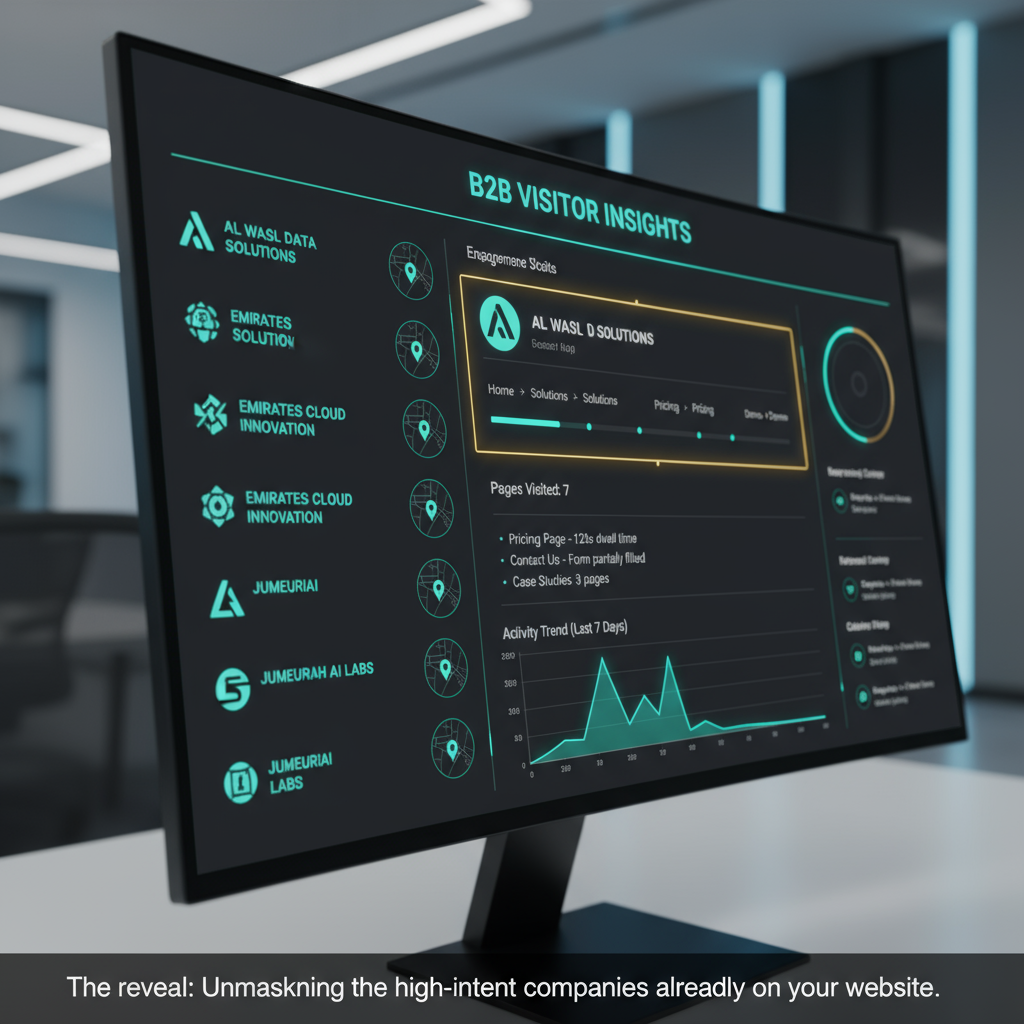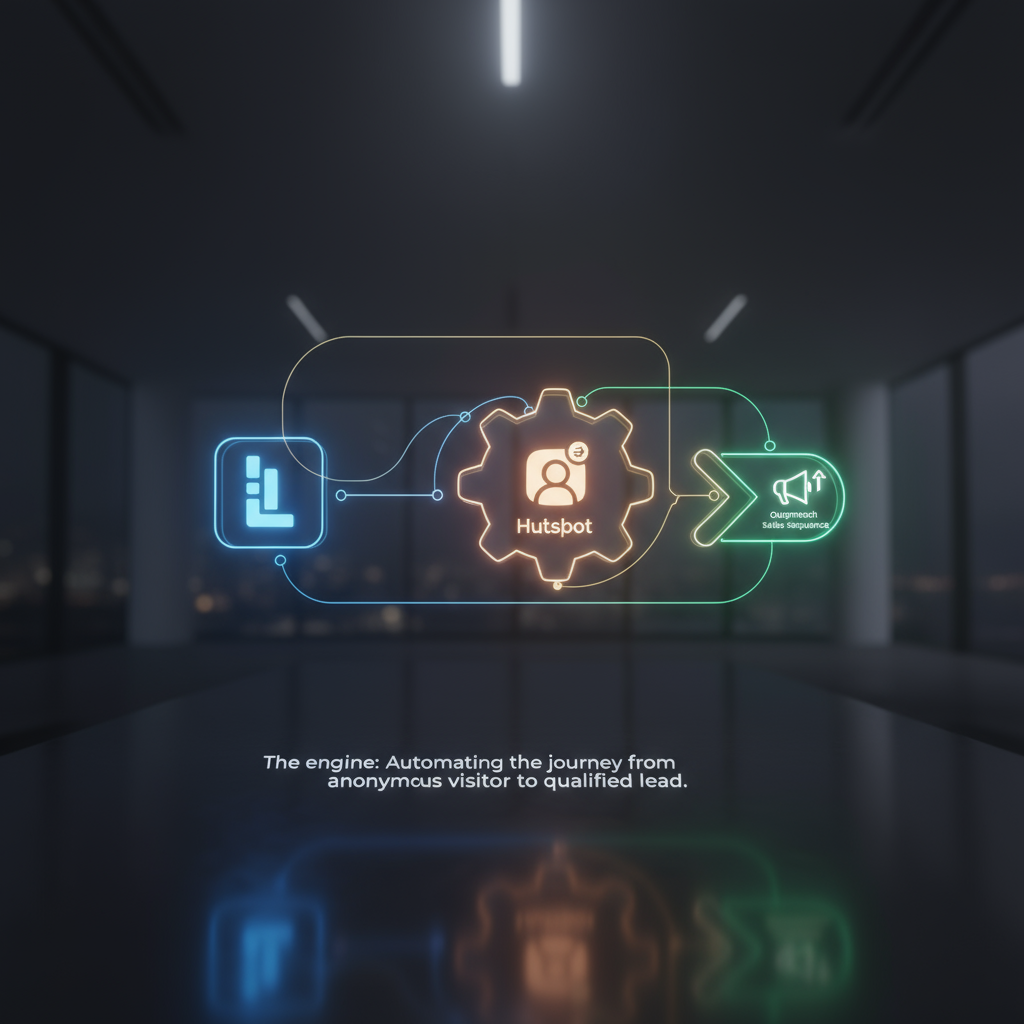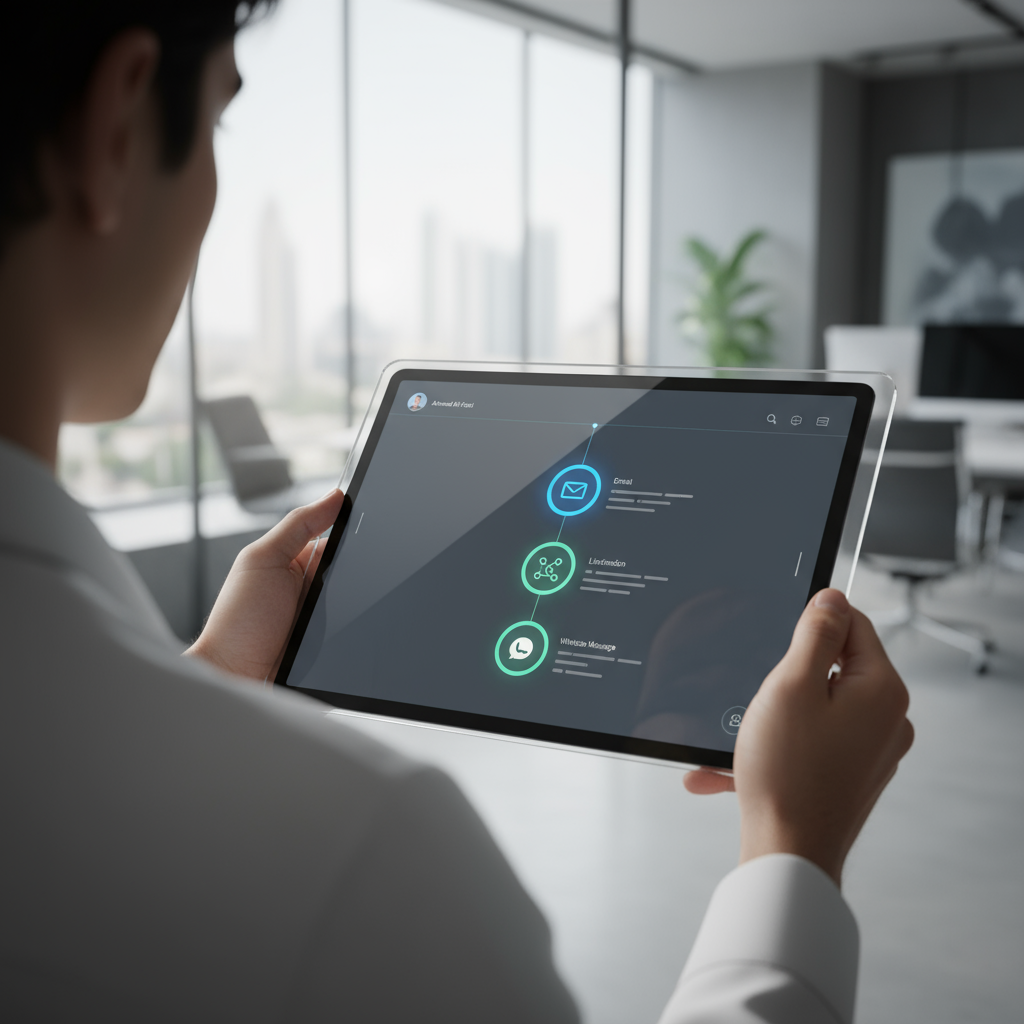Your website is a leaky bucket. Let's fix it.
Your website gets traffic, but nearly 98% of those visitors never fill out a form. They're ghosts—anonymous companies clicking your pricing page, reading case studies, and then vanishing into the digital ether. This isn't just lost traffic; it's your hidden pipeline. This playbook gives you the tools and workflows to unmask those high-intent companies and turn their silent interest into booked meetings.
Key Takeaways:
- Turn Ghosts into Gold: Learn how to reliably identify anonymous website visitors and see the actual UAE-based companies evaluating your business right now.
- Focus on the Signal: Implement a simple scoring framework to prioritize accounts that perfectly match your Ideal Customer Profile (ICP) and show clear buying intent.
- Automate Your Outreach: Map a hands-free, UAE-compliant outreach sequence that connects with the right people at the right time, without feeling creepy.
- Build Your Engine: Integrate tools like Leadfeeder, HubSpot, and n8n to build a B2B lead generation machine that runs while you sleep.
- Stop Wasting Time: Transform your website from a passive digital brochure into an active, measurable source of qualified sales pipeline.
The Problem: Guesswork Doesn't Scale
Every B2B founder knows the frustration of seeing website analytics full of "direct" or "organic" traffic that leads to zero inquiries. Who are they? Are they competitors, students, or your next enterprise client? Relying on contact forms alone means you're operating on incomplete data, letting perfectly good, high-intent leads slip away every single day. The good news? You don’t have to guess anymore. Modern B2B reveal technology gives you the map to this hidden goldmine.

A Practical Framework: The "Reveal & Respond" Playbook
We developed this four-step process to systematically convert anonymous traffic into tangible sales opportunities. It’s not about magic; it’s about having a clear, repeatable workflow that combines smart technology with a human touch.
Step 1: Install the Reveal Engine
The first step is to start collecting data. This works by adding a small piece of code (a pixel) to your website from a visitor identification tool like Leadfeeder, 6sense, or Clearbit. When a person visits your site from their company’s network, the tool uses their IP address and other data points to match it to a company profile. It’s a simple, powerful way to see the firmographics behind the clicks. It’s the foundation for everything that follows.
Step 2: Triage and Prioritize with ICP + Intent Scoring
Once the data flows, you'll see dozens, maybe hundreds, of companies. Warning: not all of them are leads. Chasing everyone is a waste of time. You must separate the signal from the noise. We use a simple scoring checklist to instantly triage visitors based on how well they fit our Ideal Customer Profile (ICP) and their behavior on the site (intent).
Here’s a basic template to adapt:
| Attribute / Behavior | Score (1-5) | Your Notes |
|---|---|---|
| ICP Fit: Industry matches our target | 5 | e.g., SaaS, Logistics, FinTech |
| ICP Fit: Employee size (e.g., 50-200) | 4 | Our sweet spot |
| ICP Fit: HQ is in the UAE/MENA | 5 | Local focus is critical |
| Intent Signal: Viewed Pricing Page | 5 | High commercial intent |
| Intent Signal: Dwelled on a Case Study > 60s | 4 | Shows deep interest |
| Intent Signal: Visited 3+ pages | 3 | Engaged user |
An account scoring 15 or higher is a high-priority lead. This simple audit turns a noisy list of 100 companies into a focused list of 5-10 accounts worth your sales team's immediate attention. One client using this method increased their demo-booked rate by 35% in the first month by focusing only on accounts that scored above 20.
Step 3: Wire the Automation Workflow
Now, let's put the process on autopilot. Manually checking a dashboard, researching contacts, and adding them to a CRM is a time sink. This is where you build an AI workforce to connect the systems. A simple workflow using a tool like n8n or Make.com can save your sales team 8+ hours per week.

- Identify & Score: Leadfeeder (or similar) flags a new company that exceeds your score threshold (e.g., >15).
- Sync & Enrich: The workflow automatically creates or updates the company in HubSpot. Next, it uses a tool like Clay.com to find the most relevant contact (e.g., Head of Operations, Founder) and their details.
- Alert & Assign: The new, enriched lead is assigned to a sales rep in HubSpot, and a real-time notification is sent to a dedicated Slack channel.
This ensures high-intent leads are actioned in minutes, not days. The team at Future & Happiness Dubai specializes in designing these exact workflows.
Step 4: Launch a UAE-Compliant, Multi-Channel Outreach
You’ve identified a high-value account and the right person to contact. Now what? Blasting a generic "I saw you were on my website" email is creepy and ineffective. In the UAE, a consent-first, multi-channel approach that respects local business etiquette is crucial.
A simple, effective sequence looks like this:
- Day 1 (Email): The Helpful Nudge. Context is key. Lead with value, not surveillance.
- "Hi [First Name], saw on LinkedIn that [Company Name] is hiring for sales roles. It got me thinking about how leaders in your space are tackling lead qualification. If you're the right person, I have a case study on how we helped [Similar UAE Company] automate their inbound funnel and cut sales-rep response time in half. Worth a look?"
- Day 3 (LinkedIn): Connect. Send a connection request. No pitch. Just get on their radar.
- Day 5 (WhatsApp - use with care): For high-priority contacts where the channel is appropriate, a soft, permission-based follow-up can work wonders.
- "Hi [First Name], Sarah here from F&H. Following up on my email regarding sales automation. Is this a topic on your radar for Q4?"
This approach feels personal and relevant. It starts a conversation by offering value, which is the foundation of modern selling. Once a lead responds, the process can flow directly into your automated lead qualification system, ensuring you stop wasting sales time on manual follow-up.

Frequently Asked Questions About Visitor Identification
How can I see which companies visit my website?
You can use a B2B visitor identification tool like Leadfeeder, 6sense, or Clearbit. You add a small script (pixel) to your website, and these tools use IP address lookup and other data points to match anonymous traffic to company profiles.
How does B2B website visitor tracking work?
It primarily works by reverse-DNS lookup. When an employee visits your site from their office network, their IP address is often registered to their company. The tracking tool maintains a large database matching IP addresses to companies, allowing it to identify the visitor's organization.
Is it legal (GDPR/PDPL) to identify website visitors?
Yes, when done correctly. Identifying a company (a legal entity) is generally considered legitimate interest under regulations like GDPR. However, identifying and contacting a specific individual requires a clear legal basis and compliant outreach practices. It's crucial to be transparent and provide easy opt-outs. This playbook focuses on identifying companies, not individuals without consent.
How accurate is IP-to-company data?
It's highly accurate for visitors using a corporate network but less so for remote workers using a home ISP or a VPN. Most top-tier tools claim an accuracy rate of 80-95% for company identification. They often use multiple data sources to improve accuracy.
How do you convert anonymous traffic into leads?
By following the "Reveal & Respond" framework: 1) Use a tool to identify the company. 2) Score them based on your ICP and their on-site behavior. 3) Find the right contact at the high-scoring companies. 4) Initiate a relevant, value-driven outreach sequence.
Can you identify individual visitors on a website?
Generally, no—not without them providing their information (e.g., filling out a form). Visitor ID tools identify the *company* or organization. Identifying specific individuals without their consent would violate privacy regulations like GDPR. The strategy is to identify the account, then use professional networking tools like LinkedIn to find the most relevant person to contact.
What is the difference between firmographic and intent data?
Firmographic data is about the company itself: industry, size, location, revenue (e.g., "A logistics company in Dubai with 100 employees"). Intent data is about their behavior: what they do on your site, what they search for online (e.g., "They read your case study on warehouse automation"). Combining both is the key to effective prioritization.
Your 3-Step Action Plan to Get Started
Turning anonymous traffic into a real pipeline isn't a complex, multi-year project. It's a series of small, logical steps you can start today. See more insights on our blog.
- Install a Reveal Pixel (1 Hour): Start a free trial with a tool like Leadfeeder. Getting the code on your site is simple and will begin collecting data immediately. Let it run for a week.
- Define Your Scoring (2 Hours): Use our ICP + Intent checklist as a starting point. Sit down with your sales team and define what a "perfect" lead looks like based on their company profile and website behavior.
- Manually Execute Your First Sequence (1 Week): Identify your top 5 highest-scoring accounts from the data. Manually research the best contact and run the UAE-compliant outreach sequence. Once you prove the model works, you can invest in automating it.



